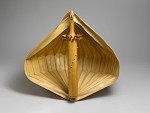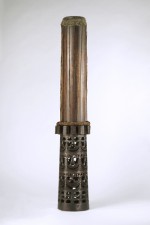Column Name
Title
One day in December when walking past the Metropolitan Museum of Art, not intending to go inside, I was stopped dead in my tracks by a poster. It was for an exhibition titled “Sounding the Pacific: Musical Instruments of Oceania.” Here was a show embodying the combination of music and art that is the focus of much of my teaching.
A tube zither, or sesando, from Timor, an island in Indonesia that is part of the East Nusa Tenggara province, is included in “Sounding the Pacific.” The late-19th century instrument is made of bamboo, wood, palm leaves, and metal wire.
(Photo by Photo courtesy of the Metropolitan Museum of Art)A drum, carved by Omas, from the Asmat people of Papua New Guinea, is also included in the exhibit. The instrument, which dates to the mid-20th century, is made of wood, lizard skin, paint, and fiber.
(Photo by Photo courtesy of the Metropolitan Museum of Art)Body
The poster itself is a work of art. At first I thought it was a photograph of a sculpture by Noguchi or another modernist 20th-century artist. The “sculpture” was organic and sleek looking, with a long wooden shaft in the center. Palm leaves fanned out, and the piece resembled the interior of a flower bud or the ribs of a boat. On closer viewing I found out that it was, in fact, not a sculpture per se, but rather, a musical instrument. Called a tube zither or sesando, it comes from Timor, an island in Indonesia that is part of the East Nusa Tenggara province. The instrument is made of bamboo, wood, palm leaves, and metal wire; it is only about 22⅙ inches high. The poster piqued my curiosity, and I soon found myself inside the exhibition.
Clearly for Oceanic peoples, the arts are not a thing apart from, but, rather, essential to the functioning of religion, ritual, and everyday life. The instruments on display come from different parts of Oceania; they are exceptional in many ways. They are divided into groups of percussion, stringed instruments, and wind instruments. Since they play an integral part in each society, their makers have drawn no distinction for them as entertainment, nor limited them as “art.” Until now, they were relegated in the West to ethnographic, anthropologic, or other collections. Perhaps this explains why this is the first exhibition of its kind to take place in an art museum. There is no question now, however, that they fit equally well here.
The tube zither from the poster is one of the most remarkable string instruments in Oceania. It has 10 or 11 metal strings set in a resonator made from the frond of a palm. The right hand plucks the bass strings while the left plays the treble. Pitch can be adjusted by means of moveable bridges and tuning pegs. The music it produces is thought by islanders to possess supernatural powers, and is used to accompany philosophical songs—songs dealing with life, its fleeting nature, and its disappointments. The tube zither is sometimes also played as a solo instrument. It was probably made by a member of a community originating on the neighboring island of Roti.
Another spectacular instrument in the exhibition is a lute (hasapi) from Sumatra, Indonesia, created by the Toba Batak people in the late-19th to early-20th century. Constructed of wood and metal, it is long and thin (30½ inches long). A carved figure of a small man, clasping his knees and wearing an elegant cap, is seated on a sort of column at the end of the instrument’s neck. Appropriately, this lute has historically been used as part of a courtship ritual to win the love of a woman.
Percussion instruments of all kinds make up a large part of the exhibit. They range from huge slit gongs to small drums. Large drums and gongs are often used for communication between individual people or villages, but they are also associated with creation myths. One such story tells of a primordial being named Fumeripits who carved figures to keep him company because he was lonely. However, the figures remained lifeless until he invented a drum and beat them into life.
One of my favorite drums is from the Asmat people of Papua New Guinea. It stands slightly less than two feet tall. We know that it was commissioned from a master carver; we even know his name, Omas. Made of wood, lizard skin, paint, and fiber, the hourglass-shaped drum has a handle depicting a standing nude man, his head that of a black king cockatoo; he seems to be pecking at the drum. Its shape and dynamism—as well as the negative space and surface carving—are spectacular.
There are some crazy wind instruments, including a side-blown trumpet and a nose flute. That’s not a misprint. The flute in the exhibit, which comes from Fiji and was made around 1830, was played by holding one nostril closed and blowing into the flute with the other. Like many other instruments in the exhibit, it features intricate carvings. Apparently it produces a soft, plaintive sound, and is used for courting or relaxation.
Although the exhibit is quite small, the objects in it are intrinsically beautiful. In contrast to the Western instruments in the Met’s musical instrument collection, these cannot be separated into visual and aural parts. Neither function is subordinated to the other. Form cannot easily be separated from function.
There is a long history of decoration in musical instruments in the West. Indeed, during the Baroque and Rococo eras, exuberant embellishments sometimes threatened to overwhelm the function of the musical instrument. Even as far back as the Middle Ages and into antiquity, musical instruments were made to look beautiful. The organ, for instance, often was adorned with ornamental sculpture matching its architectural site. Decorated instruments from as far back as ancient Greece and Egypt have even been found.
One of the casualties of the industrial era and mass production is the loss of instrumental decoration. By the turn of the 20th century, hand-decorated instruments had all but vanished. To some degree, a recent renewed interest in early music has led to a revival of instruments produced in the historically correct manner. But most orchestral instruments today are produced almost entirely for functionality.
Clearly, the main explanation for the incredible visual beauty of the Oceanic instruments is the intrinsic value these societies place on music and the art. A secondary one might reflect the lack of advanced industrialization in these countries.
The one disappointment I had in this remarkable show was the audio guide. It only provided samples of music from a very small number of instruments on view, leaving me to wonder what the others sound like. And it is expensive to rent. I did not think it worthwhile.
The show is small, easy to take in, and invaluable for musicians to see. It is not only a treat for the eyes, but also provides a window into the culture of parts of the world with which most of us are not that familiar.






